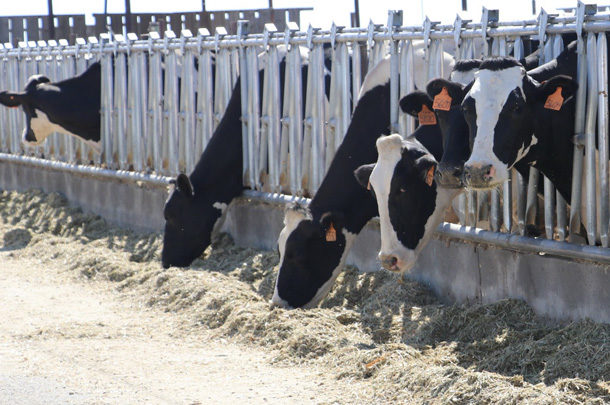Volatile prices and unavailable ingredients may prompt you and your nutritionist to modify rations. In light of this new reality, evaluating your feed and nutrition program is increasingly important. Considering the overall value of your farm’s feed management practices and how they affect your operation in the short term and long term is a good place to start.
How do I manage short-term risk?
A cow’s rumen environment needs a consistent nutrient supply to effectively feed its microbes and optimize fermentation. Plant shutdowns and trucking issues have created tight supplies and delivery challenges for certain ingredients. Be aware of these risks and have proactive (versus reactive) discussions with feed suppliers to better understand if, and when, your ingredient supplies will be affected. Your nutritionist may be able to make small adjustments to certain ingredients without forward planning, but communication and relationships with feed suppliers are more valuable now than ever.
Consistent nutrient supply is certainly an important goal, but the fermentation process in the rumen is flexible enough to utilize many different carbohydrates as fuel. Sugars, starches, soluble fiber and digestible neutral detergent fiber (NDF) can each be fermented to yield key nutrients the cow uses to produce milk and components. The amounts of those carbohydrates can be shifted within a ration and still deliver high cow performance. However, cow response may depend on stage of lactation, reproductive status and environmental conditions. Shifting carbohydrate amounts too quickly and without considering other effects (like rate of digestion and balancing with fiber and protein pools) can negatively impact rumen fermentation. Your nutritionist can guide you through carbohydrate changes and an effective ration formulation system can help to optimize diet costs as well.
Regional byproducts can also play a role in managing short-term risk. The standard class of dairy ration byproducts like canola, distillers, soybean meal, soy hulls and gluten feeds are widely available throughout the U.S. These byproducts can travel farther and cheaper based on sheer quantity and because they are dry. Regional byproducts (mostly wet feeds) stay local due to trucking expenses, making them cheaper for producers in that area. Another question to consider is how long each regional byproduct will be available. This will help you and your nutritionist use regional byproducts to get the most value out of price, without compromising animal health and production.
How do I manage long-term risk?
As an industry, we spend a lot of time managing short-term risk due to quickly changing commodity markets and current supply chain disruptions. However, thinking bigger picture surrounding longer-term risk can help minimize these short-term impacts and guide dairies toward greater financial stability.
Nutritionists are often substituting soyhulls for a lack of digestible fiber or soybean meal for lower-protein alfalfa haylages. The disruptions that create shortages in these ingredients emphasize the necessity to maximize nutrient value of on-farm feedstuffs. Major opportunities on-farm to minimize dependence on commodity markets can include improving forage digestibility, kernel processing, fermentation profiles and feed-out stability.
Matching home-grown forage and grain crop supply to optimal herd size is another longer-term opportunity. One of the first questions we learned the answer to during the beginning of the pandemic was, “Do I have the right number of animals for this facility?” When quota caps and milk dumping began, many farms implemented more aggressive culling strategies, with one problem – removing cull animals did not drop milk in the bulk tank. Another area that came under spotlight was excess heifer populations. In both cases, we were feeding additional animals that were not necessarily contributing to the bottom line.
Overpopulation can lead to various situations: higher purchased-feed costs, shifting more acreage from grain to forage production to meet inventory needs, needing to purchase more grain stemming from the lower grain acreage or compromising forage quality to meet quantity demands. By optimizing herd size, we can redirect our focus to what feeds we need to grow in order to reduce what feeds we need to buy.
What is my shrink percent, how can we lower it and should we invest?
One area that can easily be overlooked and can have a vast effect on your feed costs is shrink. Shrink measures opportunity loss on the farm based on how ingredients are handled and stored. When evaluating shrink, frequent questions include:
- Am I using the right equipment to measure out ingredients?
- Am I overloading the bucket or moving too quickly while transporting feedstuffs?
- Do I have the right storage systems matched with the right feedstuff?
With growing concern around feedstuff shortages and a heavier reliance on byproduct usage, the more common question is, “Should we invest in commodity storage facilities on-farm?”
While on-farm commodity storage can contribute to lowering shrink, it also allows producers to take advantage of spot market buys and flexibility in shifting supply chains. Work with your nutritionist to evaluate byproduct opportunities on the market and the economic return needed to pay for the facilities.
Look at shrink through a formulation perspective too. A 5% shrink on soybean meal not only means losing 5% of the physical ingredient between purchase and what the cow sees, but it also means adding 5% on top of the price paid for the ingredient. This is known as shrink-adjusted pricing. The question to ask here is, “Am I price selecting ingredients with shrink adjustments included?” Our feed software allows the opportunity to use shrink-adjusted prices during ration formulation, which in turn leads to more accurate feed-cost predictions and better ingredient buys. While the goal should be to minimize shrink, formulating rations with shrink adjustments can capture its opportunity loss and apply it to ingredients for price evaluation.
Can additives fill a gap during logistical shortages?
With a variety of additive options and each farm’s unique situation, it is difficult to broadly recommend any one additive. Start by asking how the specific additive can help cows utilize your excess nutrients or ingredients – thus leveraging the ingredients you have and offsetting unavailable ingredients. For example, if you have an abundance of mid- to low-quality forage, additives that improve forage digestion may allow for less substitution of a byproduct like soyhulls.
Additives cannot directly replace ingredients, and the more a farm can lock in consistent sources of nutrients the better they can manage volatile markets. Before utilizing additives, develop a plan with your nutritionist to measure the response and evaluate return on investment.
In summary, asking the right questions is critical during times of market volatility and supply chain disruptions. Taking advantage of your current feed inventory and the flex-fuel capability of your cows is essential for your business. If you are not challenging your nutritionist and evaluating your feed management practices, you could be leaving feed and money on the table. ![]()
PHOTO: Staff photo.
-
Jay Giesy
- Dairy Technical Services
- and Nutrition Lead
- Cargill
- Email Jay Giesy
-
Mac Campbell
- East Coast Tech Manager
- Cargill
- Email Mac Campbell








